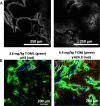Clinical translation of antibody drug conjugate dosing in solid tumors from preclinical mouse data
- PMID: 38820153
- PMCID: PMC11141632
- DOI: 10.1126/sciadv.adk1894
Clinical translation of antibody drug conjugate dosing in solid tumors from preclinical mouse data
Abstract
Antibody drug conjugates (ADCs) have made impressive strides in the clinic in recent years with 11 Food and Drug Administration approvals, including 6 for the treatment of patients with solid tumors. Despite this success, the development of new agents remains challenging with a high failure rate in the clinic. Here, we show that current approved ADCs for the treatment of patients with solid tumors can all show substantial efficacy in some mouse models when administered at a similar weight-based [milligrams per kilogram (mg/kg)] dosing in mice that is tolerated in the clinic. Mechanistically, equivalent mg/kg dosing results in a similar drug concentration in the tumor and a similar tissue penetration into the tumor due to the unique delivery features of ADCs. Combined with computational approaches, which can account for the complex distribution within the tumor microenvironment, these scaling concepts may aid in the evaluation of new agents and help design therapeutics with maximum clinical efficacy.
Figures



Similar articles
-
Atypical antipsychotics for disruptive behaviour disorders in children and youths.Cochrane Database Syst Rev. 2017 Aug 9;8(8):CD008559. doi: 10.1002/14651858.CD008559.pub3. Cochrane Database Syst Rev. 2017. PMID: 28791693 Free PMC article.
-
A rapid and systematic review of the clinical effectiveness and cost-effectiveness of paclitaxel, docetaxel, gemcitabine and vinorelbine in non-small-cell lung cancer.Health Technol Assess. 2001;5(32):1-195. doi: 10.3310/hta5320. Health Technol Assess. 2001. PMID: 12065068
-
Systemic pharmacological treatments for chronic plaque psoriasis: a network meta-analysis.Cochrane Database Syst Rev. 2021 Apr 19;4(4):CD011535. doi: 10.1002/14651858.CD011535.pub4. Cochrane Database Syst Rev. 2021. Update in: Cochrane Database Syst Rev. 2022 May 23;5:CD011535. doi: 10.1002/14651858.CD011535.pub5. PMID: 33871055 Free PMC article. Updated.
-
Interventions for eye movement disorders due to acquired brain injury.Cochrane Database Syst Rev. 2018 Mar 5;3(3):CD011290. doi: 10.1002/14651858.CD011290.pub2. Cochrane Database Syst Rev. 2018. PMID: 29505103 Free PMC article.
-
Imatinib for the treatment of patients with unresectable and/or metastatic gastrointestinal stromal tumours: systematic review and economic evaluation.Health Technol Assess. 2005 Jul;9(25):1-142. doi: 10.3310/hta9250. Health Technol Assess. 2005. PMID: 15985189
Cited by
-
Antitumor Activity of a Pyrrolobenzodiazepine Antibody-Drug Conjugate Targeting LGR5 in Preclinical Models of Neuroblastoma.Pharmaceutics. 2024 Jul 15;16(7):943. doi: 10.3390/pharmaceutics16070943. Pharmaceutics. 2024. PMID: 39065640 Free PMC article.
-
Diverse Roles of Antibodies in Antibody-Drug Conjugates.Pharmaceuticals (Basel). 2025 Jan 29;18(2):180. doi: 10.3390/ph18020180. Pharmaceuticals (Basel). 2025. PMID: 40005994 Free PMC article. Review.
-
Mechanistic Characterization of the Potency of THIOMAB Antibody-Drug Conjugates Targeting Staphylococcus aureus and ETbR-Expressing Tumor Cells Using Quantitative LC-MS/MS Analysis of Intracellular Drug Accumulation.Bioconjug Chem. 2025 Apr 16;36(4):652-661. doi: 10.1021/acs.bioconjchem.4c00533. Epub 2025 Apr 3. Bioconjug Chem. 2025. PMID: 40179311
-
Homogeneous antibody-drug conjugates with dual payloads: potential, methods and considerations.MAbs. 2025 Dec;17(1):2498162. doi: 10.1080/19420862.2025.2498162. Epub 2025 May 5. MAbs. 2025. PMID: 40322862 Free PMC article. Review.
-
Aptamers as Diagnostic and Therapeutic Agents for Aging and Age-Related Diseases.Biosensors (Basel). 2025 Apr 5;15(4):232. doi: 10.3390/bios15040232. Biosensors (Basel). 2025. PMID: 40277546 Free PMC article. Review.
References
-
- Johnson J. I., Decker S., Zaharevitz D., Rubinstein L. V., Venditti J. M., Schepartz S., Kalyandrug S., Christian M., Arbuck S., Hollingshead M., Sausville E. A., Relationships between drug activity in NCI preclinical in vitro and in vivo models and early clinical trials. Br. J. Cancer 84, 1424–1431 (2001). - PMC - PubMed
-
- Kelland L. R., Of mice and men. Eur. J. Cancer 40, 827–836 (2004). - PubMed
-
- De Jong M., Maina T., Of mice and humans: Are they the same?—Implications in cancer translational research. J. Nucl. Med. 51, 501–504 (2010). - PubMed
Publication types
MeSH terms
Substances
Grants and funding
LinkOut - more resources
Full Text Sources
Medical

